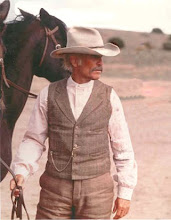Charles Goodnight (March 5, 1836 – December 12, 1929) was a cattle rancher in the American West. He was born in Macoupin County, Illinois, the fourth child of Charles and Charlotte (Collier) Goodnight. He moved to Texas in 1846 with his mother and stepfather, Hiram Daugherty. In 1856, he became a cowboy and served with the local militia, fighting against Comanche raiders. A year later, in 1857, Goodnight joined the Texas Rangers. At the outbreak of the Civil War, he joined the Confederacy. Most of his time was spent as part of a frontier regiment guarding against raids by Indians. Following the war, he became involved in the herding of feral Texas Longhorn cattle northward from West Texas to railroads. In 1866, he and Oliver Loving drove their first herd of cattle northward along what would become known as the Goodnight-Loving Trail. Goodnight invented the chuckwagon, which was first used on this cattle drive.
On July 26, 1870, Goodnight married Mary Ann (Molly) Dyer, a schoolteacher from Weatherford, Texas. Goodnight developed a practical sidesaddle for his wife to use.
In 1876, Goodnight founded what was to become the JA Ranch in Palo Duro Canyon.
Charles Goodnight statue outside of the Panhandle-Plains Historical Museum at the West Texas A&M University campus.In addition to raising cattle, Goodnight preserved a herd of native American Bison, which survives to this day. He also crossbred buffalo with domestic cattle, which he called cattalo.
Goodnight became sick after his wife's death in April of 1926, but was nursed back to health by Corinne Goodnight, a 26 year old nurse and telegraph operator from Butte, Montana, with whom Charles had been corresponding because of their shared surname.
In his last years he mined in Mexico and tried to become a movie producer. On March 5, 1927, Charles turned 91 and married the very young Corinne Goodnight. Goodnight died on December 12. 1929, in Phoenix, Arizona.
Named after Goodnight are Charles Goodnight Memorial Trail, the Panhandle town of Goodnight, Texas, (former site of the Goodnight Baptist College and birthplace in 1920 of the renowned scientist Cullen M. Crain), several streets in the Panhandle, and the highway to Palo Duro Canyon State Park. Goodnight is also known for guiding Texas Rangers to the Indian camp where Cynthia Ann Parker was recaptured, and for later making a treaty with her son, Quanah Parker.
Larry McMurtry based the relationship between Gus McCrae and Woodrow Call on the relationship between Goodnight and Loving, in his Pulitzer Prize winning novel "Lonesome Dove" and its sequels. The grave marker Call carves for one of the characters late in the novel is based on an actual gravestone Charlie Goodnight had created, and the trek back to Texas at the end of the novel is based on Goodnight's return of Loving's body to Texas. There are other notable influences from Goodnight's life in the novel as well.
All four novels include brief appearances by Goodnight, and he plays his largest role in the final (chronological) volume of the series, Streets of Laredo. Charles Goodnight is very famous around Canyon and Amarillo, Texas. Goodnight also appears briefly in the prequel Dead Man's Walk and in a more prominent role in the sequel Streets of Laredo, where he and Call have become good friends. Goodnight is played in the film by James Gammon. The Western novelist Matt Braun's novel Texas Empire is based on the life of Goodnight and fictionalizes the founding of the JA Ranch.
Thursday, June 18, 2009
Subscribe to:
Post Comments (Atom)




No comments:
Post a Comment